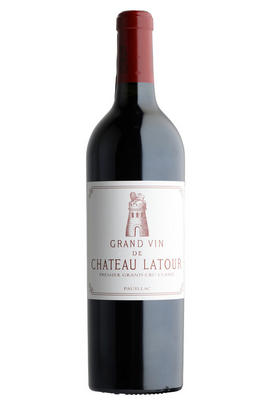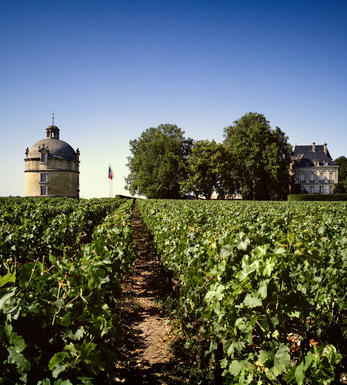
2013 Château Latour, Pauillac, Bordeaux

Critics reviews
The 2013 Latour comes from an infamous growing season that saw 30% more rain than the 25-year average and outbreaks of botrytis from 20 September, just seven days prior to the picking that was completed on 11 October. Deep purple in color, initially it has a relatively light bouquet compared to other vintages, scents of blackberry, raspberry preserve and pencil shavings plus hints of gravel. There are certainly no vegetal or green aromas. It has commendable purity, though it does not possess the complexity of profundity of a bona fide great Latour. Monitoring over time, it coheres and gains delineation, peaking about two or three hours after opening, so do not be averse to a short decant. The palate is medium-bodied with graphite-tinged black fruit, just a touch of cracked black pepper and noticeable salinity on the finish. Whilst it does not have Latour’s signature backbone or gravitas, it is approachable, harmonious and winsome. Frankly, it’s about as good as the Left Bank gets in this vintage.
Drink 2022-2032
The 2013 Latour is absolutely gorgeous. Of course, the 2013 is lighter in body than the norm here, but striking aromatics and silky tannins more than make up for that. A wine of total breed and class, the 2013 is a real pleasure to taste today. Naturally, the lighter structure of the year is impossible to escape. Even so, at eight years of age, the 2013 is just starting to show the first signs of aromatic nuance, and yet it remains a young wine. The spread of botrytis led to an early harvest, with the exception to some blocks on the western side of the enclos that were more resistant to conditions and were therefore picked later. This is a remarkable showing considering a little more than 2/3rds of the vineyards (for the Grand Vin) were farmed biodynamically back then. I can't wait to see how the 2013 ages. My opened bottle stayed fresh for a number of days.
Drink 2021 – 2033
Antonio Galloni, vinous.com (Mar 2021)
Composed of 95.2% Cabernet Sauvignon, 4.4% Merlot and 0.4% Petit Verdot, the 2013 Latour offers an open-knit, fragrant nose of licorice, sandalwood, rose petals and cigar box over a core of Black Forest cake, stewed plums, mulberries and redcurrant jelly, plus a waft of cast-iron pan. The elegantly styled, medium-bodied palate (13% alcohol) fills the mouth with intense red and black berry preserves layers, framed by evolved, soft-textured tannins and well-knit freshness, finishing long and spicy. This vintage does not have the power and backbone of an outstanding vintage of Latour, but it is aging gracefully and, still possessing a lot of discernible fruit with plenty of tertiary pizazz, is absolutely delicious to drink right now. This sweet-spot stage is likely to continue for another 5-7 years, before the wine plateaus at a maturity peak and holds for a further 15+ years.
Drink 2021 - 2041
Lisa Perrotti-Brown, Wine Advocate (Mar 2021)
Very enticing sweet tobacco, cedar, tar and blackcurrant on the nose with hints of black mushrooms and violets. It’s full-bodied with layers of ripe tannins that are still slightly chewy, but show poise and focus. Juicy finish with a berry, iodine and walnut aftertaste. Just a touch of austerity at the end. Savory. Clearly one of the top wines of this very difficult vintage, along with Margaux and Lafleur. Drinkable now, but better in 2024.
James Suckling, jamessuckling.com (Apr 2021)
First things first - there is an undeniable enjoyment in finding a vintage of Latour's grand vin that doesn't need to be put away for a few decades, and it is smart of the estate to release this wine now, at eight years old, because 2013 is unquestionably a year that lacks the intensity and structure to allow long ageing. I tasted it both on its own, just opened from bottle, and over lunch to see how it held up. Smoke, floral notes and spice are the three main lines that you are going to find, and each one has its appeal. Expect raspberry, blueberries, cassis bud and cherry pit - all markers of a cooler vintage - together with a seductively intense level of retro-olfaction that brings in waves of peony, smoked tea, tomato leaf and rosemary aromatics. The Latour tannins build slowly over the palate, although they are finer than you find in most vintages, and overall there is a successful emphasis on precision and finesse. 31% of the total production. At the time around half of the main L'Enclos vineyard was in organic and biodynamic farming, and this was the last year with Penelope Godefroy as winemaker, before she headed over to the newly bought (and now re-sold) Right Bank estates of Vray Croix de Gay and Le Prieuré. Around half the usual production, no more than 5,000 cases, because the final yield came in at 25hl/ha. In my view, one of the wines of the vintage.
Drink 2021 – 2038
Jane Anson, Decanter.com (Feb 2021)
About this WINE

Château Latour
Château Latour is a wine estate in Pauillac, part of the Haut-Medoc sub-region on the Left Bank of Bordeaux. The estate’s history dates back to at least the 14th century, though vineyards were not established here until the 17th century. The estate is located at the southern edge of the Pauillac appellation, bordering the St Julien vineyards of Château Léoville Las Cases. Latour is one of the five First Growths of the 1855 classification, occupying the top tier alongside Châteaux Lafite Rothschild, Margaux, Haut-Brion, and Mouton Rothschild.
Latour is owned by François Pinault, one of France’s wealthiest people. It forms the jewel in the crown of Pinault’s Artémis Domaines, itself part of the larger Groupe Artémis. Other wineries within the portfolio include Clos de Tart and Domaine d’Eugénie in Burgundy; Château Grillet in the Rhône Valley; Champagne Jacquesson; Eisele Vineyard in California’s Napa Valley; and Maisons et Domaines Henriot, which includes holdings in Champagne, Burgundy, and Oregon.
The day-to-day running of Latour is entrusted to the dynamic Frédéric Engerer. Under his stewardship, a major programme of investment has taken place. In 2012, Latour announced that it would no longer offer its wines as part of the Bordeaux En Primeur campaign. Instead, the wines are kept at the estate until such a time as they are ready to be opened and enjoyed. They are then offered through the La Place de Bordeaux distribution system several years after the vintage.
There are three wines produced here. Château Latour, the grand vin, is produced from vines immediately surrounding the château, from the vineyard area known as L’Enclos. Les Forts de Latour, the second wine, was created in 1966. It is now regarded as a great wine in its own right, certainly worthy of Classified Growth status. A third wine, Pauillac de Latour, is usually the product of young vines.
The vineyard is planted to a majority of Cabernet Sauvignon, along with some Merlot and small amounts of Cabernet Franc and Petit Verdot.

Pauillac
Pauillac is the aristocrat of the Médoc boasting boasting 75 percent of the region’s First Growths and with Grand Cru Classés representing 84 percent of Pauillac's production.
For a small town, surrounded by so many familiar and regal names, Pauillac imparts a slightly seedy impression. There are no grand hotels or restaurants – with the honourable exception of the establishments owned by Jean-Michel Cazes – rather a small port and yacht harbour, and a dominant petrochemical plant.
Yet outside the town, , there is arguably the greatest concentration of fabulous vineyards throughout all Bordeaux, including three of the five First Growths. Bordering St Estèphe to the north and St Julien to the south, Pauillac has fine, deep gravel soils with important iron and marl deposits, and a subtle, softly-rolling landscape, cut by a series of small streams running into the Gironde. The vineyards are located on two gravel-rich plateaux, one to the northwest of the town of Pauillac and the other to the south, with the vines reaching a greater depth than anywhere else in the Médoc.
Pauillac's first growths each have their own unique characteristics; Lafite Rothschild, tucked in the northern part of Pauillac on the St Estèphe border, produces Pauillac's most aromatically complex and subtly-flavoured wine. Mouton Rothschild's vineyards lie on a well-drained gravel ridge and - with its high percentage of Cabernet Sauvignon - can produce (in its best years) Pauillac's most decadently rich, fleshy and exotic wine.
Latour, arguably Bordeaux's most consistent First Growth, is located in southern Pauillac next to St Julien. Its soil is gravel-rich with superb drainage, and Latour's vines penetrate as far as five metres into the soil. It produces perhaps the most long-lived wines of the Médoc.
Recommended Châteaux
Ch. Lafite-Rothschild, Ch. Latour, Ch. Mouton-Rothschild, Ch. Pichon-Longueville Baron, Ch. Pichon Longueville Comtesse de Lalande, Ch. Lynch-Bages, Ch. Grand-Puy-Lacoste, Ch, Pontet-Canet, Les Forts de Latour, Ch. Haut-Batailley, Ch. Batailley, Ch. Haut-Bages Libéral.

Cabernet Sauvignon Blend
Cabernet Sauvignon lends itself particularly well in blends with Merlot. This is actually the archetypal Bordeaux blend, though in different proportions in the sub-regions and sometimes topped up with Cabernet Franc, Malbec, and Petit Verdot.
In the Médoc and Graves the percentage of Cabernet Sauvignon in the blend can range from 95% (Mouton-Rothschild) to as low as 40%. It is particularly suited to the dry, warm, free- draining, gravel-rich soils and is responsible for the redolent cassis characteristics as well as the depth of colour, tannic structure and pronounced acidity of Médoc wines. However 100% Cabernet Sauvignon wines can be slightly hollow-tasting in the middle palate and Merlot with its generous, fleshy fruit flavours acts as a perfect foil by filling in this cavity.
In St-Emilion and Pomerol, the blends are Merlot dominated as Cabernet Sauvignon can struggle to ripen there - when it is included, it adds structure and body to the wine. Sassicaia is the most famous Bordeaux blend in Italy and has spawned many imitations, whereby the blend is now firmly established in the New World and particularly in California and Australia.


Buying options
Add to wishlist
Description
The 2013 Latour comes from an infamous growing season that saw 30% more rain than the 25-year average and outbreaks of botrytis from 20 September, just seven days prior to the picking that was completed on 11 October. Deep purple in color, initially it has a relatively light bouquet compared to other vintages, scents of blackberry, raspberry preserve and pencil shavings plus hints of gravel. There are certainly no vegetal or green aromas. It has commendable purity, though it does not possess the complexity of profundity of a bona fide great Latour. Monitoring over time, it coheres and gains delineation, peaking about two or three hours after opening, so do not be averse to a short decant. The palate is medium-bodied with graphite-tinged black fruit, just a touch of cracked black pepper and noticeable salinity on the finish. Whilst it does not have Latour’s signature backbone or gravitas, it is approachable, harmonious and winsome. Frankly, it’s about as good as the Left Bank gets in this vintage.
Drink 2022-2032
wine at a glance
Delivery and quality guarantee